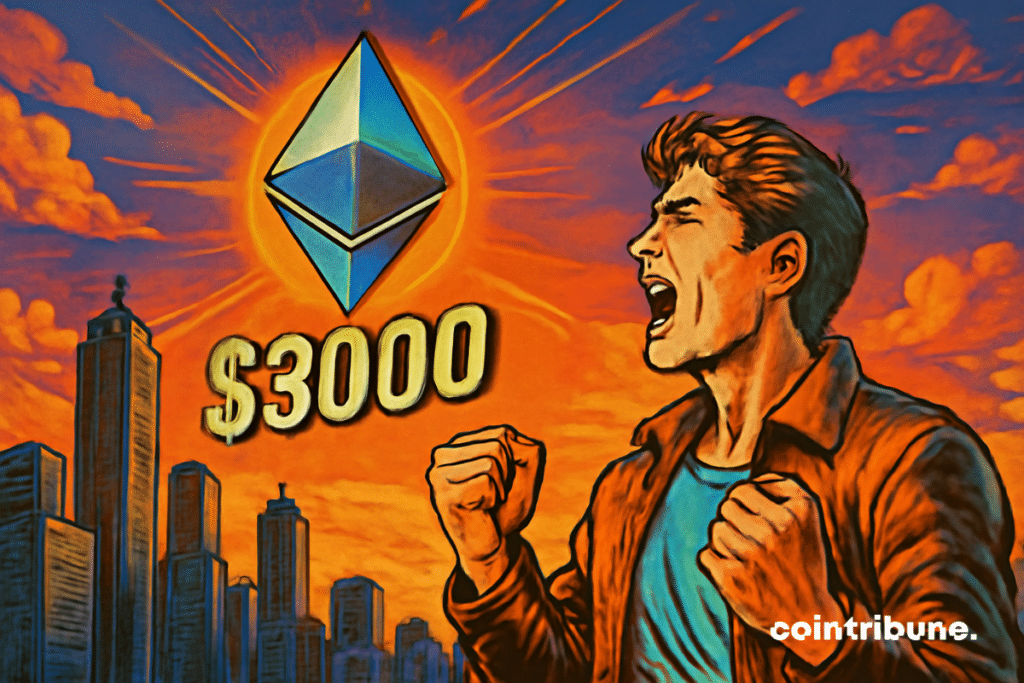Crypto: ETH Is Approaching The Crucial $3,000 Zone!
Ethereum has never really left investors’ radar. But these past few days, a particular thrill is running through the crypto market. With a swift leap towards $2,700, the prospect of a return to $3,000 is becoming clearer. It is no longer a distant hypothesis, but a scenario regaining momentum. And behind this rise, a simple reality: profits are being reborn, and with them, the market’s appetite.

In Brief
- Ethereum jumped from $1,800 to $2,700, rekindling investor enthusiasm and profit hopes.
- $2,800 level represents a critical point, where a wave of selling could slow the momentum towards $3,000.
- The massive influx of capital via ETFs quietly fuels the rise and could push ETH to a new all-time high.
The Shadow of a Renewal: Crypto ETH Flirts with the Peaks
Ethereum did not simply rebound – it surged. From $1,800 to $2,700 in one week, the world’s second-largest crypto just reminded the entire ecosystem that the lions sleep lightly. And when the price crosses its realized price – in this case $1,900 – investors wake up, their wallet lighter, certainly, but morale boosted.
This comeback is no accident. It is fueled by the rise of the “Pectra” update, whose technical effects have created an environment ripe for optimism. Result: more than 52% increase in eight days, and a return above several psychological thresholds. But beware, the current upswing is only a prelude. Because the crypto market remains wary, oscillating between euphoria and methodical caution.
Behind this rise, an entire army of investors regains color. Those who had been stuck in latent losses for months are returning to balance. And this breath of fresh air, often underestimated, gives the crypto community an essential fuel: hope.
The $2,800 Wall: Last Frontier before $3,000
But before popping the champagne, a major obstacle remains to be overcome, as Cointelegraph highlights: the $2,800 level, where about 2.27 million ETH have been bought. This level could trigger massive sales, as many investors simply seek to recover their initial investment.
If this threshold is crossed with strength, it could trigger a true short squeeze, propelling ETH towards the famous $3,000 mark. But conversely, any sharp rejection around this level would revive doubts. The technical history is clear: to sustainably regain a bull market, Ethereum will have to turn this resistance into strong support.
The analysis of the 50- and 100-day moving averages confirms this tension zone. Since February, they have served as a glass ceiling. To break through, more than enthusiasm will be needed: volume, momentum, and – above all – a conviction shared by institutional investors.
Perhaps this is where the master card lies. The growing interest in Ethereum ETFs, with over $100 million in net inflows in just three days, is no coincidence. It is a strong signal, often invisible to the retail investor but heavy with consequences for the crypto market structure. These flows create a mechanical, regular buying pressure, disconnected from daily volatility.
If this trend continues, it could well play the role of catalyst in the conquest of $3,000. Because ETFs, unlike short-term traders, are not intended to sell at the slightest turbulence. They accumulate. This discrete but steady accumulation gradually reconfigures the supply dynamics. At this pace, it could well propel ETH to a new all-time high, much like what has recently been observed with bitcoin.
Maximize your Cointribune experience with our "Read to Earn" program! For every article you read, earn points and access exclusive rewards. Sign up now and start earning benefits.

Fascinated by Bitcoin since 2017, Evariste has continuously researched the subject. While his initial interest was in trading, he now actively seeks to understand all advances centered on cryptocurrencies. As an editor, he strives to consistently deliver high-quality work that reflects the state of the sector as a whole.
The views, thoughts, and opinions expressed in this article belong solely to the author, and should not be taken as investment advice. Do your own research before taking any investment decisions.